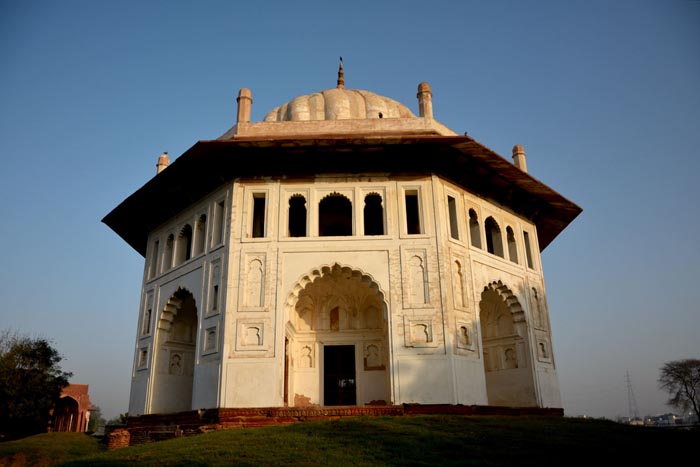Tomb of Salabat Khan

Information on Tomb of Salabat Khan (Agra, Uttar Pradesh) - History & Architecture
Tombs of Sadiq and Salabat Khan is another popular monument which was left behind by Mughal rulers. It is also known as 'Chausath Khamba' or 'Chand Bibi Palace'. It is located in Gelana village, on the northern portion of Agra-Delhi national highway, next to the tomb of his father named Sadiq Khan. Tombs of Sadiq and Salabat Khan is created by Salabat Khan himself at an average elevation of 900 meter above the sea level and 800 feet above the city.
Tomb of Salabat Khan Architecture
The architecture of Tombs of Sadiq and Salabat Khan is exclusive and the entire area of the monument is appropriately maintained. It is surrounded by a three storey building. The tomb is quite large and is observable from long distance. The foundation of the tomb was laid on a circular plan, but the monument is in octagonal structure. Created completely on red sandstone, Tomb of Salabat Khan spreads categorically on parallel axis. It is enclosed by water plans such as central waterways, fountains, alleyways and sporadic cascades among others. The building is initially presented with symphonic and metrical view.
Tomb of Salabat Khan is essentially a hall with 64 columns made from red sandstone and possessing attractive rectangular umbrella on each of the four sides. The frontage of the tomb is made up of agallery of five arcs which is supported on twin columns. The hall of the tomb is divided into 25 rectangular inlets and is open on every angles. The central inlets is comparatively bigger than other inlets. The central inlets contain the cenotaph and the actual grave of Salabat Khan which is initially accessible by a passageway on every portion.
Initially, there was a cover which protected the building externally on every sides. However, at present only the brackets of the cover have survived. Possibly there was a superstructure on every angles of the monument, symphonically adjoining the central pavilion. Nevertheless, only traces of the superstructure have remained nowadays. Furthermore, the constructor of Tomb of Salabat Khan and his wife are also buried in the subterranean vault. Three other tombs of Salabat Khan's second wife and sons are buried outside the tomb.
Tomb of Salabat Khan History
Tomb of Salabat Khan was created between the years 1644 to 1650 by Salabat Khan, the son of Sadiq Khan. Salabat Khan was one of the renowned ministers of Murtaza, the fourth Nizam king. Murtaza created his empire throughout the year 1565 to 1579. During his realm, Murtazade clared Salabat Khan as his trustworthy minister. The tomb reveals various instances and historic occurrences which resulted in the death of Salabat Khan.
Salabat Khan was also regarded as king Shahjahan's treasurer. He served the emperor with complete devotion. However, in the year 1644, Rao Amar Singh Rathore, the son of King Gaj Singh Rathore of Jodhpur and elder brother of King Jaswant Singh disrespected Salabat Khan by imposing certain comments. Ultimately, Rao Amar Singh Rathorepierced him to death by a dagger in 'Diwan-i-Aam' which is situated in Agra Fort. The incident occurred with the presence of emperor Shahjahan. Afterwards, Rao Amar Singh Rathore was chased and executed near Akbar Gate, which in later phase retitled as 'Amar Singh Gate' by the British rulers.
Tomb of Salabat Khan Tourism Importance
Tomb of Salabat Khan belong to such era where architectural effect was key concern of constructers. The tomb stand a unique architecture with beautiful surroundings, making it a worthy place for tourism. Travellers who are interested in history and architecture can find Tomb of Salabat Khan as a stimulating place to visit. The place is also popular for the purpose of picnic.
- Andaman Nicobar Monuments
- Andhra Pradesh Monuments
- Assam Monuments
- Bihar Monuments
- Chhattisgarh Monuments
- New Delhi Monuments
- Goa Monuments
- Gujarat Monuments
- Haryana Monuments
- Himachal Pradesh Monuments
- Jammu and Kashmir Monuments
- Karnataka Monuments
- Kerala Monuments
- Madhya Pradesh Monuments
- Maharashtra Monuments
- Odisha Monuments
- Punjab Monuments
- Rajasthan Monuments
- Tamil Nadu Monuments
- Telangana Monuments
- Uttar Pradesh Monuments
- West Bengal Monuments